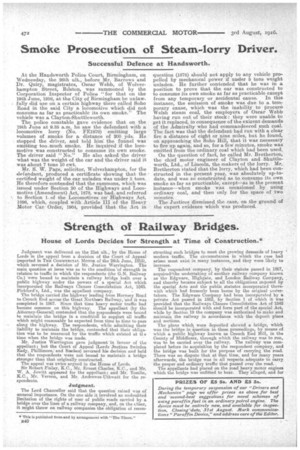Strength of Railway Bridges.
Page 12

If you've noticed an error in this article please click here to report it so we can fix it.
House of Lords Decides for Strength at Time cif Construction.*
Judgment was delivered on the 21st ult., by the House of Lords in the appeal from a decision of the Court of Appeal (reported in THE CommEncrar Moron of the 24th June, 1915), which reversed a decision of Mr. Justice Warrington. The main question at issue was as to the condition 'of strength in relation to traffic in which the respondents (the G.N. Railway Co.) were bound to maintain a railway bridge built over a public highway under the powers of a special Act which incorporated the Railways Clauses Consolidation Act, 1845. Pickford's, Ltd., was the appellant company.
The bridge carried the highway leading from Hornsey Road to Crouch End across the Great Northern Railway, and it was completed in 1867. Since that time heavy motor traffic had become common on this highway. The appellant (by the Attorney-General) contended that the respondents were bound to maintain the bridge in a condition to support all traffic which might reasonably be expected from time to time to pass along the highway. The respondents, while admitting their liability to maintain the bridge, contended that their obligation was to be measured by the traffic which existed at tie time when the bridge was made.
Mr. Justice Warrington gave judgment in favour of the appellant; but the Court of Appeal (Lords Justices Swinf en Early, Phillimore ' and Barikes) reversed his decision and held that, the respondents were not bound to maintain a bridge stronger than that originally constructed. The appeal was twice argued in the House of Lords. Sir Robert Finlay, K.O. Mr. Ernest Charles, K.C., and Mr. W. A. Jowitt appeared ior the appellant; and Mr. Tomlin, K.C., Mr. Vernon, and Mr. Andrewes-Uthwatt for the respondents.
Judgment.
The Lord Chancellor said that the question raised i.as of unusual importance. On the one side it involved an undoubted limitation of the rights of user of public roads carried by a bridge over the lines of a railway company, and, on the (titer, it might throw on railway companies the obligation of reeon structing such bridges to meet the growing demands of leavy modern traffic. The circumstances in which the case had arisen must exist in many instances, and they were likely to increase.
The respondent company, by their statute passed in 1867, acquired1the undertaking of another railway company known. as the Edgware, Highgate, and London Railway Company, and thereby became subject to all the obligations imposed by the special Acts and the public statutes incorporated therewith which 'had formerly been borne by the original i4n dertakers. The Edgware Company had been incorporated by a private Act passed in 1862, by Section 1 of which it was provided that the Railways Cla,nses Consolidation Act of 1845 should be incorporated with and form part of the special Act, while by Section 19 the company was authorized to make and maintain the railway in accordance with the deposit plans and sections. • The plans which were deposited showed a bridge, which Was the bridge in cjuestion in these proceedings, by means of which a public highway known as Crouch End Hill, in the County a Middlesex, through which the railway was to run, was to be carried over the railway. The railway was completed before its acquisition by the respondent company, and the bridge was built for the purpose of carrying the road. There was no dispute that at that time, and for many years afterwards, the bridge was in all respects adequate to carry the proper and ordinary traffic that passed over the road.
The appellants had placed on the road heavy motor engines which the bridge was unfitted to bear. They alleged, and for




















